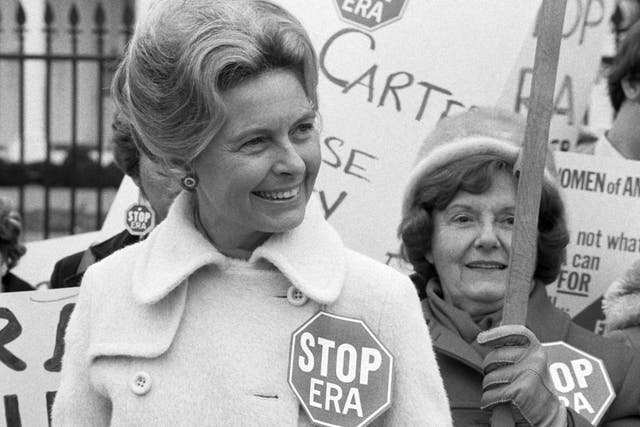
The ERA was on track to become the 27th amendment to the U.S. Constitution. Then a grassroots conservative movement halted its momentum.
Updated: September 29, 2023 | Original: March 19, 2020

In 1972, it seemed ratification of the Equal Rights Amendment was all but a sure thing.
First introduced to Congress in 1923 by suffragist Alice Paul, the proposed 27th Amendment to the U.S. Constitution, which stated "Equality of rights under the law shall not be denied or abridged by the United States or by any state on account of sex," had passed with both bipartisan and public support and was sent to the state legislatures for ratification.
The Equal Pay Act of 1963But the ERA included a seven-year ratification time limit clause (which Congress extended to 1982), and although 35 of 38 state legislatures needed for a three-quarters majority had voted to ratify the amendment, its proponents hadn’t counted on a conservative grassroots movement led by activist and lawyer Phyllis Schlafly that would ultimately lead to the ERA’s defeat, falling three states shorts.
"What I am defending is the real rights of women," Schlafly said at the time. "A woman should have the right to be in the home as a wife and mother."
Don Critchlow, author of Phyllis Schlafly and the Grassroots Right and Future Right, and the Katzin Family Professor at Arizona State University, says one issue was the amendment was loose in its wording.
“That meant it was going to have to be interpreted by the courts and she—and her large number of followers—were concerned that the courts would interpret it as abortion on demand, same-sex marriage and women in the draft.” he says. “Furthermore, she felt that much of the legislation protecting women in pay and gender discrimination had already been enacted.”
The ERA got as far as it did, due to the work of second-wave feminists who had lobbied for years for its passage. Those who fought for the amendment included prominent figures such as Gloria Steinem, Betty Friedan and Jane Fonda. Brandy Faulkner, a visiting assistant professor at Virginia Tech’s College of Liberal Arts and Human Sciences, says the feminist momentum influenced not only Congress, but also the U.S. Supreme Court. Faulkner points out that Eisenstadt v. Baird, which established the right of unmarried people to possess contraception on the same basis as married couples, passed in 1971—just a year after Congress passed the ERA.
Schlafly’s strategy to defeat the ERA was to convince women that equality between men and women was undesirable.
“She consistently painted worst-case scenarios which, when juxtaposed with the lives of average white women at that time, led many of them to believe that inequality wasn't so bad after all," Faulkner says. “She was a biological determinist who thought that the physiological differences between men and women should be the primary determiner of their roles. She advocated for what she thought was a privileged position for women in society."
One example Schlafly offered was that women did not have to register for the draft—a fact that Schlafly argued was a female privilege. Schlafly also applauded that fact that for most social welfare programs, women were assumed to be dependents of their husbands, and that entitled them to some government services and benefits.
Schlafly's conservative values led her to staunchly oppose feminism in all of its forms, Faulkner says, and the ERA was certainly part of the feminist agenda.
“She feared that greater sex equality would lead to a moral decline in society by changing the roles that women had traditionally held,” she says.
Critchlow, author of In Defense of Populism (to be released in the fall of 2020), says Schlafly, who died at age 92 in 2016, built up her following through her work with the National Federation of Republican Women, which became the basis for Stop ERA.
“She was articulate, quite intelligent and extremely well organized and she was deadly on the debate stage,” he says.
Schlafly’s strategy was to organize grassroots women in the multiple states to put pressure on the state legislatures to stop or rescind ERA passage.
“I’m absolutely convinced that it would have passed without her involvement,” he says. “She was able to single-handedly organize the Stop ERA movement.”
As the Stop ERA movement gained momentum, Critchlow adds, it was able to reach new constituencies, particularly in the Southern battleground states.
“The women involved in southern state organizations were able to tap into the churches, especially the evangelical churches,” he says. “Schlafly was Catholic, but she was able to reach out not only to Protestants, but also to Mormons, as well as some traditional Jews, too.”
By the late 1970s, Schlafly had risen in prominence for pushing back against the feminist movement. Her book, The Power of the Positive Woman, helped cement her following. But public opinion of Schlafly remained divided.
"Women who were opposed to her absolutely despised her," Critchlow says.
Following the ERA’s defeat, Schlafly and Stop ERA threw a party, according to a 1982 report in the Washington Post.
“Ronald Reagan sent a congratulatory telegram," according to the Post, "The band played ‘Ding, Dong, the Witch is Dead.’ Conservative Digest editor John Lofton, who wore dark glasses and a striped party hat, put it this way: ‘We're here to celebrate a death, to dance on a grave.’”
Stream acclaimed women's history documentaries in HISTORY Vault.